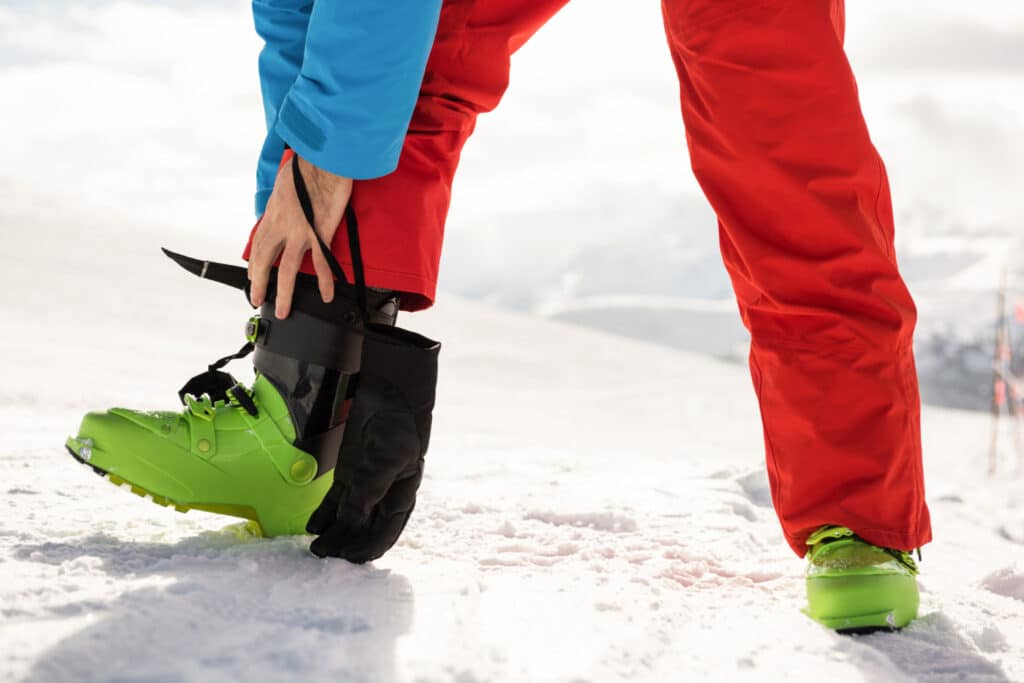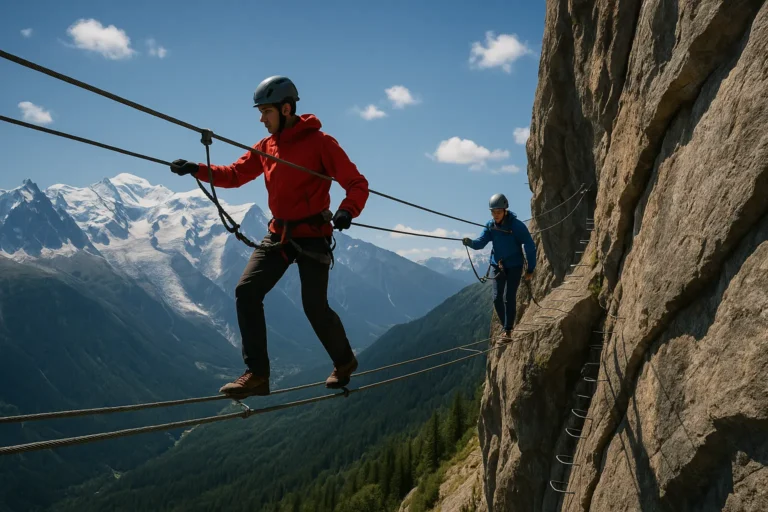Want some help choosing the right ski boot size? Finding the correct ski boot size is key to achieving the perfect balance of comfort, performance, and safety on the slopes. Whether you’re shopping for men’s ski shoes or lightweight models, getting the right size will help you enjoy every run — and avoid injury or discomfort.
The most reliable way to select your ski boot is by using the Mondopoint (Mondo) system, which measures foot length in millimetres. This universal ski boot sizing system simplifies the process and helps prevent fit issues when switching between brands, styles, or ski boot types.
Ski boots typically vary in width from 92 mm (for narrow feet or racing) to 104 mm (for wider feet or comfort-oriented designs). Choosing the correct size means considering not just length, but also foot width, volume, and the type of skiing you plan to do. This guide delivers key content to help you find the right ski boots — whether you’re a beginner or a pro.
Why a Precise Fit Matters
A ski boot that fits well enhances precision, control, and comfort. Poorly fitted shoes can cause pain, pressure points, and instability, making your ski day uncomfortable — or even dangerous.
- Too tight? Expect numbness, reduced blood circulation, and stiff movement.
- Too loose? You’ll lose control, reduce power transfer to your skis, and risk injury.
An accurate fit allows your movements to transfer directly to your skis, improving stability, balance, and edge control — whether you’re carving down icy runs or enjoying fresh powder.
Understanding the Mondo Size System
The Mondopoint system, often simply called Mondo size, measures the exact length of your foot in millimetres. It’s a universal guide used across nearly all ski boot manufacturers and is especially helpful when buying online or comparing brands.
- A Mondo 27 boot is designed for a foot that’s roughly 270 mm long (or 27 cm).
- Most brands add a few millimetres of interior space for comfort and sock thickness.
- Mondo sizes can also be converted from UK, EU, or US shoe sizes using a conversion chart (see FAQ below).
Pro tip: Always measure both feet, try them on with ski socks, and consult the brand’s size guide before ordering new ones.
Find the Right Ski Boot Type and Size for Your Skill Level
Getting the right ski boot size is only one part of the equation — you also need to select the type of boot that matches your experience, weight, and skiing style. A good fit not only improves comfort but also enhances performance, helping you stay in control whether you’re a beginner or a seasoned skier.
Determine the Right Flex Based on Experience
The flex rating of a ski boot refers to how stiff or responsive the boot is. This is a crucial sizing factor that affects how your shoes react to your movements on skis.
- Beginners should look for a soft flex (around 60–80) for maximum comfort, ease of use, and forgiving support — ideal for learning and building confidence.
- Intermediate skiers often benefit from a medium flex (90–110), offering better control while maintaining some comfort and flexibility.
- Advanced and expert skiers, including those doing freestyle or aggressive all-mountain skiing, typically need a stiff flex (120+) for precision, power transfer, and fast response.
Tip: Your weight also affects flex choice. A heavier skier may need a stiffer boot for support, even at a lower skill level. Always check the manufacturer’s sizing and flex chart for guidance.
Choose Between Performance Fit and All-Day Comfort
Skiers face a common decision when choosing boots: should you go for performance or comfort?
- A performance fit usually features a narrower last (98–100 mm), a higher flex, and snug liners. These ski shoes are designed to deliver fast, accurate response and are best for advanced skiers who prioritise control.
- A comfort-focused fit offers more room (lasts 100 mm or more), a lower flex, and softer liners — perfect for recreational skiing or those who value all-day warmth and ease of use.
If you’re unsure, consider an all-mountain boot, which balances responsiveness and comfort — making it ideal for those who ski a variety of terrains and conditions.
Whether you’re shopping for men’s ski boots, lightweight equipment, or your first ones, make sure to match both size and flex to your actual needs. This improves control and reduces fatigue so you can ski longer with better results.
Practical Tips When Buying Ski Boots
Why Boot Width and Fit Volume Matter
When shopping, understanding fit volume — also called boot “last” — is essential. This includes the internal width, height, and depth of the boot. Two pairs with the same size can feel completely different due to varying volume and shape.
Here’s a general ski boot width guide:
- 97–100 mm last: Best for narrow feet
- 100–102 mm last: Suited for average feet
- 104 mm and up: Designed for wide feet
Remember, the last width increases slightly with boot size. Choosing the right fit helps improve control on skis, reduces fatigue, and prevents painful pressure points.
How to Try Ski Boots for the Best Fit
Getting the right boot fit takes a bit of time and care — but it’s worth it. Follow these simple tips:
- Try them at the end of the day when your feet are slightly swollen for a realistic fit.
- Wear your own ski socks to replicate conditions on the slopes.
- Get your feet measured by a professional to identify your exact size, instep height, and foot width.
- Check heel hold: A 1–2 cm gap between heel and shell is normal when standing.
- Customise yours: Thermo-mouldable liners and custom insoles can enhance comfort and performance.
- Let a boot fitter tell you if your heel hold and volume match the manufacturer’s specs.
Choosing the right ones based on your foot shape, skill level, and skiing style ensures better support, fewer injuries, and a more enjoyable time on the slopes.
Tip: Don’t forget that your gear isn’t complete without proper ski insurance. Whether you’re skiing in Europe or the UK, make sure you’re covered for accidents, medical care, and lost equipment.
Common Mistakes to Avoid When Choosing Ski Boot
Even experienced skiers can make size-related errors when shopping for boots. Here are some common pitfalls to avoid:
- Ignoring width and fit volume: Don’t just focus on length — always consider last width and instep height.
- Buying too big: Many skiers size up for comfort, but loose boots reduce control and increase injury risk.
- Not using proper socks: Wearing thick socks in-store may give a false impression. Use medium-weight ski socks instead.
- Skipping shell checks: Always perform a shell fit test to gauge internal volume and ensure a secure heel hold.
- Overlooking boot flex: A stiff boot isn’t always better — flex should match your weight and skiing level.
Avoiding these errors helps ensure a better experience, especially when shopping online or buying your first ski boots.
How Ski Boot Stiffness Affects Fit and Skiing Style
The flex index of a ski boot doesn’t just affect responsiveness — it also influences how your boot feels when you wear it. Here’s how stiffness plays into fit and function:
- Soft boots (60–80 flex): Easier to put on, more forgiving. Great for beginners, or relaxed cruising.
- Medium boots (90–110 flex): Balanced support and movement. Ideal for intermediate to advanced skiers.
- Stiff boots (120–130+ flex): Snug fit, max energy transfer. Designed for racing, freestyle, or aggressive downhill skiing.
If you ski in mixed terrain — powder, groomed pistes, off-piste — consider an all-mountain boot with a flex that adapts to multiple conditions.
Lightweight Ski Boots: What You Need to Know
For many skiers, boot weight is just as important as size and fit. Lightweight ski boots:
- Reduce leg fatigue on long days
- Improve freedom of movement
- Make walking in ski resorts or lodges easier
Look for light boots with strong support made from modern materials like Grilamid or Pebax. They’re often preferred by ski tourers, instructors, and all-mountain skiers who want versatility without compromising control.
Popular lightweight models include:
- Tecnica Zero G Tour
- Salomon Shift Pro 110
- Atomic Hawx Ultra
Final Checks Before You Buy Ski Boots Online
Buying ski boots online is convenient, but requires some smart checks:
✅ Check brand-specific sizing and conversion tables
✅ Read verified reviews about fit and comfort
✅ Choose a shop that offers free returns or size swaps
✅ Look for bundles including free shipping or discounted skis
✅ Add ski insurance to your cart to protect your new boots and equipment
Still unsure? Most online ski retailers offer live chat or size guides to help you pick the perfect fit.
A well-sized pair of boots means better technique, longer days on the slopes, and fewer aches at après-ski.






